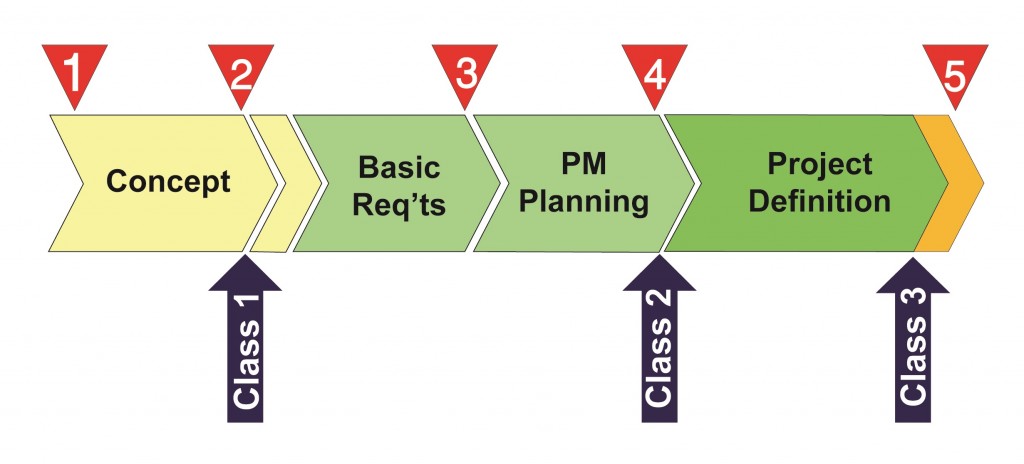This blog post is also from our upcoming book, Redefining the Basics of Project Management, scheduled for second quarter 2014. We publish this chapter in two parts.
Project Estimates across the Project Life Span
In the previous article, we discussed the three estimate classification, which we also show on this illustration.
Summary of the Three Estimates
In summary:
- Each estimate has a different purpose,
- The purpose is appropriate to a related stage in the project life span,
- Each estimate is an input to a stage gate,
- The level of estimating details and estimate accuracy is a function of the project stage,
- As a result, the uncertainty of the estimates is reduced with the subsequent estimates,
- Reducing uncertainty leads to reducing risk to an acceptable range,
- This then reduces threats and enhances the chance of project success,
- Finally, accurate estimate provides proper and realistic control baselines.
Are Three Estimates Too Many?
Maybe, maybe not!
Various resources and studies still reflect a large percent of projects fail, or at least are complete with less than optimal outcome and not delivering the expected benefits.
Why such a poor record?
We are not claiming that poor estimating causes failed and challenged projects but would it be fair to ask ‘is estimating a factor?’
We think it is appropriate to expand the discussion from estimating to the use of these estimates in making project decisions. CAM2P™ links estimating directly to the stage gates. Let us pose the question again but in a different way, did these failed or challenged projects follow a disciplined approach, using techniques and controls such as project life span and stage gates?
The issue here is this:
If an organization’s management wants to approve projects with less detailed estimates, and earlier in the project life span, say using Class 1 Estimate as the only basis for funds approval, then they must expect a higher risk of project delays and budget variances. This is because, as we already explained; the level of detail for the Class 1 is low, and the accuracy is the least of the three estimates. In other words, there is a trade-off between earlier decision-making and higher risk. If this trade-off is acceptable, then great, no issues. If not? Then think twice about this approach and consider adopting our leading practice.
Estimating and Project Management Maturity
 We mentioned earlier that there is a link between proper estimating and project management maturity. In general, the link is not limited to estimating, since all project management processes, particularly planning, are a function of an organization’s project management maturity. Since this book is not about project management maturity, we will not explain the links in details but we will touch on key points.
We mentioned earlier that there is a link between proper estimating and project management maturity. In general, the link is not limited to estimating, since all project management processes, particularly planning, are a function of an organization’s project management maturity. Since this book is not about project management maturity, we will not explain the links in details but we will touch on key points.
The most important factors that contribute to a higher level of project management maturity are components of a formal project management organizational system, such as methodology, governance, processes, lessons learned, historical data, and project records. The historical data and project records have a direct input on estimating and estimate accuracy since the estimating effort will use proper records and actual data instead of guesswork or vendor quotations. Further, vendor quotations may not be possible during the early stages of the projects since vendors need detailed design or specifications.
A non-existent or weak organizational system, lack of historical data for cost and time, and the absence of lessons learned will all contribute to poor planning; unreliable project detailed plans, and funding decisions based on questionable estimates. Moving on to implementation, poor planning will lead to numerous variances and unanticipated risks, which in turn result in the project management team spending too much time reacting to problems instead of proactive management. In these situations, the outcome is almost certain – failed or challenged projects.
The above only touches on the importance of proper estimating and project approvals and their role in effective management of projects, and in turn, higher organizational project management maturity!

